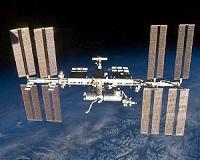 |
Houston TX (SPX) May 13, 2011 Drinkable water is one of the primary and most important assets for human survival. So when preparing for a journey, whether to sea or to space, planners must take this vital resource into consideration. Stowage space during such voyages always comes at a premium. It is no different for the International Space Station and the resupply vehicles that dock there. A great example of a solution to minimize size and weight in life support is the recently launched Sabatier system. Originally developed by Nobel Prize-winning French chemist Paul Sabatier in the early 1900s, this process uses a catalyst that reacts with carbon dioxide and hydrogen - both byproducts of current life-support systems onboard the space station - to produce water and methane. This interaction closes the loop in the oxygen and water regeneration cycle. In other words, it provides a way to produce water without the need to transport it from Earth. The fundamental technology for this particular system has been in development for the past 20 years. The overall schedule for hardware production, however, was under two years. This accelerated timeline was a significant challenge for the complex Sabatier, which contains a furnace, a multistage compressor, and a condenser/phase-separation system. The fact that recycling system feeds for Sabatier were already available on the station helped to simplify some of the design tasks by reducing the unknowns. According to Jason Crusan, chief technologist for space operations at NASA Headquarters in Washington, the previous development and solid interfaces allowed NASA to try out a new way of acquiring services for the station with Sabatier. "Being able to demonstrate innovative new methods to acquire technical capabilities is one of the key cornerstones the space station can serve for future missions and approaches to those missions," Crusan explained. Using developing technologies and productive systems enables the station to squeeze every drop from the resources that must launch from Earth. In addition to improving the efficiency of the station's resupply capabilities, Sabatier also frees up storage space. This helps to maximize the area available for science facilities and engineering equipment. The knowledge gained from such systems also advances the collective understanding of technologies to advance spaceflight and help solve similar problems on Earth. The Sabatier system has long been a part of the space station plan, but the retirement of NASA's space shuttles elevated the need for new resources to provide water. For a decade, shuttles have provided water for the station as a byproduct of the fuel cells they use to generate electricity. Sabatier supplements the capability of resupply vehicles to provide water to the station, without becoming a sole source for this critical station resource. Currently in operation on the station, Sabatier is the final piece of the regenerative environmental control and life-support system. This hardware was successfully activated in October 2010 and interacts directly with the Oxygen Generation System, which provides hydrogen, sharing a vent line. Prior to Sabatier, the Oxygen Generation System vented excess carbon dioxide and hydrogen overboard. Rather than wasting these valuable chemicals, Sabatier enables their reuse to generate additional water for the station. With room and resources at a premium in space, this is a significant contribution to the space station's supply chain.
Share This Article With Planet Earth
Related Links Johnson Space Center Station at NASA Station and More at Roscosmos S.P. Korolev RSC Energia Watch NASA TV via Space.TV Space Station News at Space-Travel.Com
 ISS orbit to be readjusted for Soyuz TMA-20 return
ISS orbit to be readjusted for Soyuz TMA-20 returnMoscow, Russia (RIA Novosti) May 06, 2011 The orbit of the International Space Station (ISS) will be raised by 1 kilometer (0.6 miles) on Thursday, Russian Mission Control said. "The readjustment is necessary to ensure the best conditions for the successful return of Soyuz TMA-20 crew to Earth on May 24," Mission Control said in a statement. Soyuz TMA-20 will bring back members of Expedition 27 - Russian cosmonaut Dmitry Kon ... read more |
|
| The content herein, unless otherwise known to be public domain, are Copyright 1995-2010 - SpaceDaily. AFP and UPI Wire Stories are copyright Agence France-Presse and United Press International. ESA Portal Reports are copyright European Space Agency. All NASA sourced material is public domain. Additional copyrights may apply in whole or part to other bona fide parties. Advertising does not imply endorsement,agreement or approval of any opinions, statements or information provided by SpaceDaily on any Web page published or hosted by SpaceDaily. Privacy Statement |